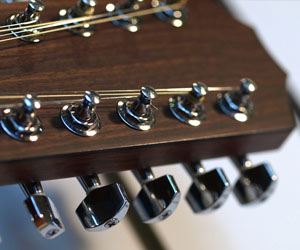Tuning Pegs for Acoustic Guitar
When dealing with guitar tuning pegs, there is a distinct difference between the realm of acoustic and electric. Electric guitars are ever more popular than ever and when you come across tuning pegs that aren't labeled for acoustic versus electric, there are ways to tell with which it is designed to be used. Tuning pegs for acoustic guitar, whether bass or standard, will often have a more classic look reflective of orchestral bass and classic guitar styling. When dealing with electric guitars, there are several designs of tuning pegs that range between classy and conservative like the pearl, Gibson turning knobs to the super-scientific, max-action machineheads designed to raise and lower pitch more per turn than other brands.
Different Tuning Pegs Between Acoustic and Electric!
The key difference between acoustic and electric guitars is that the acoustic's body is hollow and wide allowing for resonance rather than electric pickups to generate sound. The reason why there is a difference between the machineheads of acoustic and electric guitars is because of the density of the strings. Acoustic guitars often use nylon or dense, metal strings to produce sound when plucked whereas electric guitars generally use lighter metal strings. Good acoustic machineheads will hold strings tight and prevent pitch from changed even during prolonged or heavy playing. Electric tuning pegs generally won't maintain pitch if strummed violently. As the strings are lighter, the action of the head must be weaker than an acoustic head to ensure the small, metal electric guitar strings don't snap under the pressure.
The Importance of Good Tuning Pegs
There are abundant reasons why good tuning pegs for the acoustic guitar or the electric guitar are necessary.
- Good tuning pegs mean longer-lasting tone quality: If you're playing for hours a night and you often find yourself retuning before the end of a show, consider upgrading your tuning pegs. You may find your pitch shifting less throughout the night!
- Good tuning pegs mean long-lasting strings: If you have old tuning pegs, rust and wear may be making it considerably more difficult on your strings than it needs to be. Putting small strings through undue stress is a bad idea – their shelf life is already low!
- Good tuning pegs mean quicker tune ups: If you've ever cranked a machinehead several times around to get a noticeably different pitch out of your string, you could use a new set of machineheads. With new, well-greased parts, you'll find your strings tightening and loosening much quicker.
- Good tuning pegs mean better tone: Whereas with cheap, shoddy tuning pegs that inhibit the ability of the string to resonate, good tuning pegs will enhance your sound rather than hamper it.
Keeping Your Tuning Heads Well-Greased
Remember that maintenance is always key. Without proper greasing of your tuning heads, they can get stiff and stop working. By greasing your tuning heads as regularly as every month or two, you can ensure they always work as well as they did when they were first purchased and installed.

